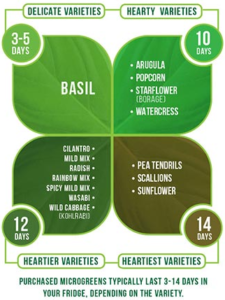Frequently asked questions
Microgreens are tiny edible plants that are older than a sprout, but younger than a full-grown plant. They are the smallest of the salad greens, and can be grown from almost any plant variety that would produce a mature plant, such as beet, radish or mustard.
Because of their size, microgreens are often confused with sprouts. They are not sprouts. Sprouts are just germinated seeds grown in water that are eaten whole, with the seed, root and stem still attached. . Microgreens are not grown in water, as are sprouts. The seed density for microgreens is much lower than for sprouts, which allows plenty of room for each tiny plant to grow, and prevents the disease problems common to sprouts. Microgreens are harvested by cutting, without any roots.
Studies have shown many microgreens, such as red cabbage, broccoli, and radish often contain up to 40 times more nutrients that mature plants. According to Professor Qin Wang at the University of Maryland, microgreens are 4 to 40 fold more concentrated with nutrients. His research team tested 25 different commercially grown microgreens, and found consistently high levels of important nutrients like vitamin C, vitamin E, vitamin K, lutein and beta-carotene. Dr Gene Lester, a USDA researcher says, “All these nutrients are extremely important for skin, eyes and fighting cancer, and have all sorts of benefits associated with them. To find these high levels of nutrients, I find that quite astonishing.”

As a general rule, purchased microgreens typically last 10-12 days in your fridge. The shelf life can vary, however, depending on the type of microgreen. For example, heartier varieties like sunflower, scallions, and pea tendrils can last up to three weeks, yet the more delicate varieties, like basil, may only last up to five days.
1) They begin to smell really bad. As with all produce, once they start to decay, they give off a foul odor. Keep in mind, that some microgreens don’t smell that great, to begin with.
For instance, take broccoli. It’s one of the most powerful microgreens but the smell isn’t much to be desired. So don’t think it’s bad just because it smells a bit. You should be able to smell the difference of decaying produce and ones that just don’t smell great based on the particular variety.
2) The stems become mushy. This is usually where decay begins.
